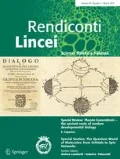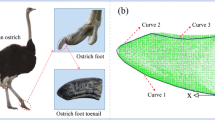Abstract
On the sand environment, the wheel surface as the key component of the interaction between vehicle and sand plays a crucial role in improving the vehicle’s trafficability. African ostrich runs in the desert all year round, and its excellent plantar friction characteristic is obvious. In this paper, a bionic wheel surface monomer was designed based on the structural characteristics of the papillae of ostrich planta and the geometric morphology of ostrich planta, and the structure of the wheel surface monomer was optimized by the discrete element method (DEM) numerical simulation. The simulation shows that the wheel surface monomer model 2-2-2 can generate greater pressure with sand, and the particle movement range is larger. Then through the friction test of four kinds of wheel surface monomers, it is found that the friction of the bionic wheel monomer A on the sand was the largest. Finally, the DEM models of the wheel with the bionic wheel surface and the wheel with conventional wheel surface were established. The wheels simulation shows that the soil thrust of the bionic wheel is 113.4% greater than that of the conventional wheel. The above research showed that the bionic papilla structure greatly improved the friction performance of the wheel surface. Moreover, the combination of the bionic protrusions and the bionic wheel surface profile designed based on the geometric morphology of ostrich’s planta can play a better role.














Similar content being viewed by others
References
Asnani V, Delap D, Creager C (2009) The development of wheels for the lunar roving vehicle. J Terramechanics 46(3):89–103
Arvidson R, Iii B, Bellutta J, Caborl P, Catalano N (2010) Spirit mars rover mission: overview and selected results from the northern home plate winter haven to the side of scamander crater. J Geophys Res-Planet 115(E7):633–650
Arvidson R, Degrosse P, Grotzinger J, Heverly M, Shechet J, Moreland S, Newby M, Stein N, Steffy A, Zhou F, Zastrow A, Vasavada A, Fraeman A, Stilly E (2017) Relating geologic units and mobility system kinematics contributing to curiosity wheel damage at gale crater, mars. J Terramechanics 73:73–93
Balaram J (2000) Kinematic state estimation for a Mars rover. Robotica 18(3):251–262
Czapla T, Fice M, Niestrój R (2019) Wheel-surface model parameters estimation: sand humidity influence on traction effort of all-terrain unmanned vehicle. Lat Am J Solids Stru 16(1):1679–7817
Chen H, Wei Q, Wen S, Li Z, Shi Y (2017) Flow behavior of powder particles in layering process of selective laser melting: Numerical modeling and experimental verification based on discrete element method. Int J Mach Tool Manu 123:146–159
Ding L, Gao H, Deng Z, Li Y, Liu G, Yang H, Yu H (2015) Three-layer intelligence of planetary exploration wheeled mobile robots: Robint, virtint, and humint. Sci China Tech Sci 58(8):1299–1317
Du Y, Gao J, Jiang L, Zhang Y (2017) Numerical analysis on tractive performance of off-road wheel steering on sand using discrete element method. J Terramechanics 71:25–43
Fan X, Deng Z, Gao H, Ding L (2014) Design & analysis of flexible wire mesh tire for manned lunar roving vehicle. J Astronaut 35(2):235–244
Hsu H-W (2012) Horányi M Ballistic motion of dust particles in the Lunar Roving Vehicle dust trails. Am J Phys. 80(5):452
Jia Y, Wei X, Pu J, Xie P, Wen T, Wang C, Lian P (2019) A numerical feasibility study of kinetic energy harvesting from lower limb prosthetics. Energies 12(20):3824
Li J, Zhuang J, Wei D (2007) Static and dynamic performances of bionic camel foot tire. Trans Chin SocAgr Mach 38(9):30–33
Li J, Hang H, Wang Y, Tian L, Ren L (2015) Research progress of soft ground machine system. J Agric Mach 46:306–320
Li C, Zhang T, Goldman D (2013) A terradynamics of legged locomotion on granular media. Science 339(6126):1408–1412
Smith N, Wilson A (2013) Mechanical and energetic scaling relationships of running gait through ontogeny in the ostrich (struthiocamelus). J Exp Biol 216(5):841–849
Schaller N, D’Août K, Villa R, Herkner B, Aerts P (2011) Toe function and dynamic pressure distribution in ostrich locomotion. J Exp Biol 214(7):1123–1130
Tong F, Zheng W, Shu F (2014) Accurate relative positioning of Yutu lunar rover using VLBI phase-referencing mapping technology. Chinese Sci Bull 59(34):3362
Xie C, Wu X, Wang X (2019) A Three-row opposed gripping mechanism with bioinspired spiny toes for wall-climbing robots. J Bionic Eng 16(6):994–1006
Yang P, Zang M, Zeng H (2019) DEM–FEM simulation of tire–sand interaction based on improved contact model. Comput Part Mech 1–15.
Yan Y, Zou M, Yao J, Yuan B, Lin Y, Jin J (2017) Endurance study of bionic wheels for mars rovers. J Terramechanics 74:57–68
Zhao Z (2006) Study of WTC5380TSM-works vehicle on desert trafficability. Mech Res Appl 4:34–36
Zhang R, Ji Q, Luo G, Xue S, Ma S, Li J, Ren L (2017) Phalangeal joints kinematics during ostrich (Struthiocamelus) locomotion. Peer J 5(1):e2857
Zhang R, Ji Q, Han D, Wan H, Li X, Luo G, Xue S, Ma S, Yang M, Li J (2018) Phalangeal joints kinematics in ostrich (Struthiocamelus) locomotion on sand. PLoS ONE 13(2):e0191986
Zhang R, Luo G, Xue S, Yang M, Liu F, Zhang S, Pan R, Li J (2015) Bionic design of configuration of rigid wheel moving on the sand and numerical analysis on its traction performance. Trans Chin SocAgrEng 31(3):122–128
Zhang R, Ji Q, Zhang S, Li J (2016) Bionic design and dynamics performance simulation of walking wheel to travel on the sand. Trans Chin SocAgrEng 32(15):26–31
Zhang R, Ji Q, Yang M, Li J (2016) Bionic design and performance analysis of drum shaped wheel of Mars rover. Trans Chin SocAgr Mach 47(8):311–316
Zhang R, Liu H, Zhang S, Zeng G, Li J (2014) Finite Element Analysis in the Characteristics of Ostrich Foot Toenail Traveling on the sand. ApplMech Mater 461:213–219
Schaller N, D’Aout K, Villa R, Herkner B, Aerts P (2011) Toe function and dynamic pressure distribution in ostrich locomotion. J Exp Biol 214(7):1123–1130
Zhang R, Yang M, Pan R, Liu H, Zeng G, Li J (2015) Mathematical model establishment of irregular plantar surface of ostrich didactyl foot. Trans Chin SocAgr Mach 31:71–78
Zhang R, Han D, Ji Q, He Y, Li J (2017) Calibration Methods of Sandy Soil Parameters in Simulation of Discrete Element Method. Trans Chin SocAgr Mach 48(3):49–56
Acknowledgements
We thank the support of the National Natural Science Foundation of China (No. 51675221, 50805064), the Science and Technology Development Planning Project of Jilin Province of China (No. 20180101077JC), the Opening Project of the Key Laboratory of Bionic Engineering (Ministry of Education), Jilin University (No. KF20200008), the Graduate Innovation Fund of Jilin University (No. 101832020CX156).
Author information
Authors and Affiliations
Corresponding author
Ethics declarations
Conflict of interest
The authors declare that they have no conflict of interest.
Additional information
Publisher's Note
Springer Nature remains neutral with regard to jurisdictional claims in published maps and institutional affiliations.
Rights and permissions
About this article
Cite this article
Pang, H., Zhang, H., Zhang, R. et al. Design of the bionic wheel surface based on the friction characteristics of ostrich planta. Rend. Fis. Acc. Lincei 32, 191–203 (2021). https://doi.org/10.1007/s12210-020-00967-x
Received:
Accepted:
Published:
Issue Date:
DOI: https://doi.org/10.1007/s12210-020-00967-x




